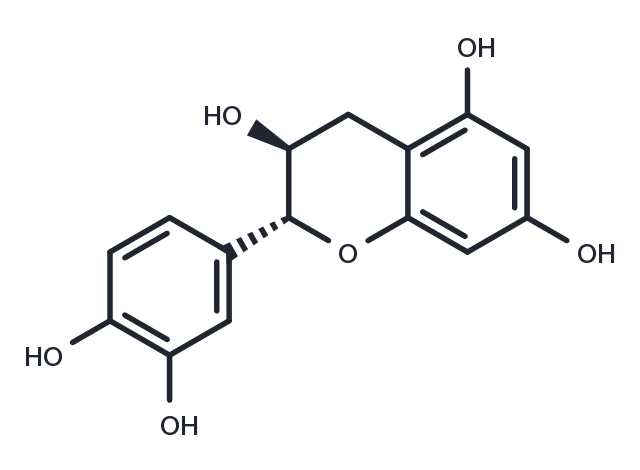Powder: -20°C for 3 years | In solvent: -80°C for 1 year
Catechin (Cianidanol) is a flavan-3-ol, a type of natural phenol and antioxidant.

| 説明 | Catechin (Cianidanol) is a flavan-3-ol, a type of natural phenol and antioxidant. |
| ターゲット&IC50 | COX-2:130 μM, COX-1:80 μM |
| In vitro | The catechin flavonoid reduces proliferation and induces apoptosis of murine lymphoma cells LB02 through modulation of antiapoptotic proteins[1]. Treatment of human prostate cancer cells with catechin induces apoptosis and results in effects on a variety of survival signals suggesting the potential of these compounds as chemopreventive agents for prostate cancer[2]. Catechin is well known to inhibit cyclooxygenase activity with reported IC50 values ranging from 4O μM to 943 μM. It has also been reported to act as an inhibitor of COX-1 and COX-2 with IC50 of about 80 μM and 130 μM[3]. |
| In vivo | Dietary catechin significantly delayed tumor onset[5]. Continued intake of catechin, a potential antioxidant, prevents memory regression and DNA oxidative damage in senescence-accelerated (SAMP10) mice. It does not prolong the lifetime of SAMP10 mice, but it does delay brain senescence[6]. (+)-Catechin inhibits intestinal tumor formation and suppresses Focal adhesion kinase activation in the Min/+ Mouse[7]. |
| 細胞研究 | LB02 cells were resuspended in RPMI 10% FBS in a concentration of 5x105 cells/mL. The cultures were performed in 96-well round-bottomed microtitre plates in presence of different concentrations of catechin or rutin (10, 50, 100 or 200 μg/mL). After 48 h at 37 ºC in a humidified atmosphere with 5% CO2 in the air, cultures were pulsed with 1 μCi of 3H-thymidine/well and maintained for an additional 18 h period prior to a semiautomatic method harvest. (Only for Reference) |
| 植物由来 |
| 別名 | Catechinic acid, D-Catechin, (+)-Catechin, Cianidanol, Catechuic acid |
| 分子量 | 290.27 |
| 分子式 | C15H14O6 |
| CAS No. | 154-23-4 |
Powder: -20°C for 3 years | In solvent: -80°C for 1 year
DMSO: 50 mg/mL (172.25 mM)
H2O: 25 mg/mL (86.13 mM ), Sonication is recommended.
Ethanol: 54 mg/mL (186 mM)
You can also refer to dose conversion for different animals. 詳細
bottom
Please see Inhibitor Handling Instructions for more frequently ask questions. Topics include: how to prepare stock solutions, how to store products, and cautions on cell-based assays & animal experiments, etc.
Catechin 154-23-4 Apoptosis Immunology/Inflammation Metabolism Microbiology/Virology Neuroscience Influenza Virus Endogenous Metabolite COX inhibit Catechinic acid D-Catechin (+)-Catechin Cianidanol Cyclooxygenase Catechuic acid Inhibitor inhibitor
